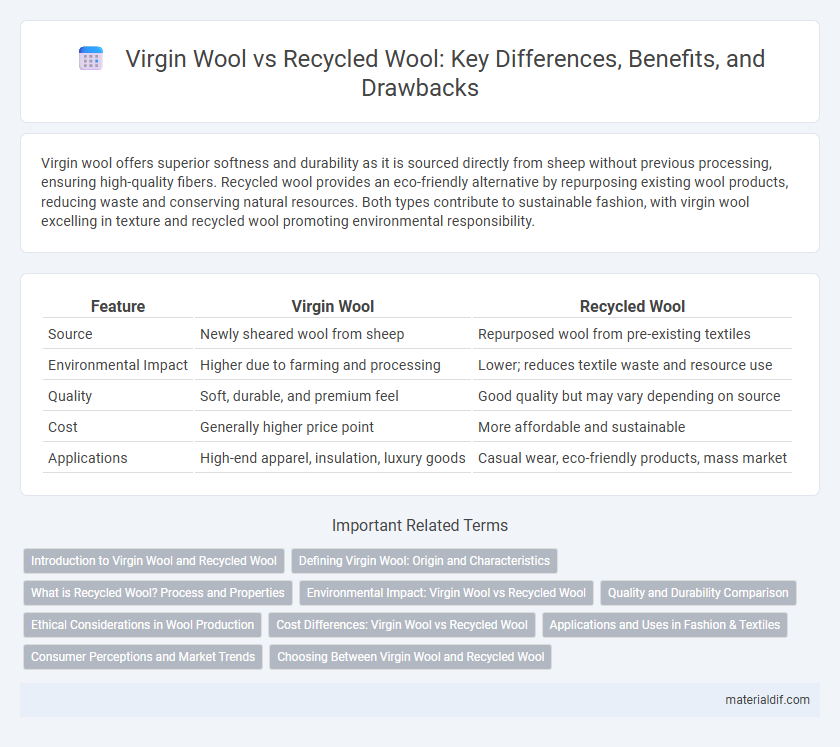Virgin wool offers superior softness and durability as it is sourced directly from sheep without previous processing, ensuring high-quality fibers. Recycled wool provides an eco-friendly alternative by repurposing existing wool products, reducing waste and conserving natural resources. Both types contribute to sustainable fashion, with virgin wool excelling in texture and recycled wool promoting environmental responsibility.
Table of Comparison
| Feature | Virgin Wool | Recycled Wool |
|---|---|---|
| Source | Newly sheared wool from sheep | Repurposed wool from pre-existing textiles |
| Environmental Impact | Higher due to farming and processing | Lower; reduces textile waste and resource use |
| Quality | Soft, durable, and premium feel | Good quality but may vary depending on source |
| Cost | Generally higher price point | More affordable and sustainable |
| Applications | High-end apparel, insulation, luxury goods | Casual wear, eco-friendly products, mass market |
Introduction to Virgin Wool and Recycled Wool
Virgin wool originates from the first shearing of sheep, ensuring fibers are fresh, strong, and undamaged, which contributes to its superior softness and durability. Recycled wool is produced by reclaiming and reprocessing wool garments or scraps, reducing waste and environmental impact by diverting textile waste from landfills. Choosing between virgin and recycled wool involves balancing premium quality and sustainability concerns within the textile industry.
Defining Virgin Wool: Origin and Characteristics
Virgin wool is derived directly from the first shearing of sheep, ensuring fibers that are clean, strong, and soft due to minimal processing. This type of wool maintains its natural crimp and elasticity, making it highly durable and ideal for premium textiles and garments. Unlike recycled wool, virgin wool retains consistent fiber length and quality, resulting in superior insulation and moisture-wicking properties.
What is Recycled Wool? Process and Properties
Recycled wool is fabric made from shredded, cleaned, and respun wool fibers derived from pre-consumer or post-consumer wool garments and textile waste, reducing environmental impact by diverting material from landfills. The process involves sorting, deconstructing, and blending old woolen textiles with virgin fibers to restore strength and elasticity while maintaining softness and warmth. This eco-friendly material retains key properties of virgin wool, such as breathability, moisture-wicking, and natural insulation, making it a sustainable alternative in the textile industry.
Environmental Impact: Virgin Wool vs Recycled Wool
Virgin wool production requires significant water, energy, and land use, contributing to higher greenhouse gas emissions compared to recycled wool. Recycled wool reduces waste by repurposing existing fibers, lowering the demand for raw resources and minimizing environmental pollution. Choosing recycled wool supports sustainable textile practices and decreases the overall carbon footprint of wool products.
Quality and Durability Comparison
Virgin wool offers superior quality due to its long, unprocessed fibers, resulting in enhanced softness, strength, and natural elasticity, which contribute to greater durability over time. Recycled wool, while environmentally beneficial and cost-effective, often contains shorter fibers and may incorporate synthetic blends, potentially reducing its resilience and softness. Choosing virgin wool ensures lasting performance and premium texture, whereas recycled wool serves as a sustainable but slightly less durable alternative.
Ethical Considerations in Wool Production
Virgin wool is sourced directly from sheep, ensuring high-quality fibers but raising concerns about animal welfare and environmental impact due to intensive farming practices. Recycled wool reduces textile waste by repurposing pre-consumer or post-consumer wool garments, minimizing landfill contributions and lowering carbon footprint. Ethical considerations prioritize animal rights, sustainable land use, and resource efficiency, making recycled wool a more responsible choice for eco-conscious consumers.
Cost Differences: Virgin Wool vs Recycled Wool
Virgin wool typically carries higher production costs due to the extensive shearing, cleaning, and processing required from raw sheep fleece, resulting in a premium price point. Recycled wool, sourced from post-consumer or post-industrial wool waste, undergoes less intensive processing but may incur additional expenses in sorting and contaminant removal, often leading to a lower price compared to virgin wool. Cost differences between virgin and recycled wool are influenced by factors such as fiber quality retention, environmental impact savings, and market demand for sustainable textiles.
Applications and Uses in Fashion & Textiles
Virgin wool, prized for its durability and softness, is commonly utilized in high-end fashion, tailoring, and luxury knitwear, offering superior insulation and resilience. Recycled wool, produced by reprocessing post-consumer textile waste, finds growing applications in sustainable fashion and eco-friendly textiles, particularly in casual wear, outerwear, and home furnishings. Both fibers contribute uniquely to the fashion industry, with virgin wool emphasizing premium quality and recycled wool advancing environmental responsibility and circular fashion initiatives.
Consumer Perceptions and Market Trends
Virgin wool is often perceived by consumers as higher quality and more durable, contributing to its premium market positioning. Recycled wool gains traction due to growing environmental awareness and demand for sustainable fashion, with its market share expanding in eco-conscious demographics. Current trends indicate a gradual shift as brands increasingly promote recycled wool for its reduced carbon footprint and resource efficiency.
Choosing Between Virgin Wool and Recycled Wool
Virgin wool offers superior softness, durability, and natural insulating properties due to its untouched fibers, making it ideal for high-quality garments and long-lasting textiles. Recycled wool emphasizes sustainability by reducing waste and environmental impact, though it may have slightly lower fiber strength and softness compared to virgin wool. Choosing between virgin wool and recycled wool involves balancing the desire for premium texture and longevity with eco-conscious efforts to minimize resource consumption and landfill waste.
Virgin Wool vs Recycled Wool Infographic

 materialdif.com
materialdif.com